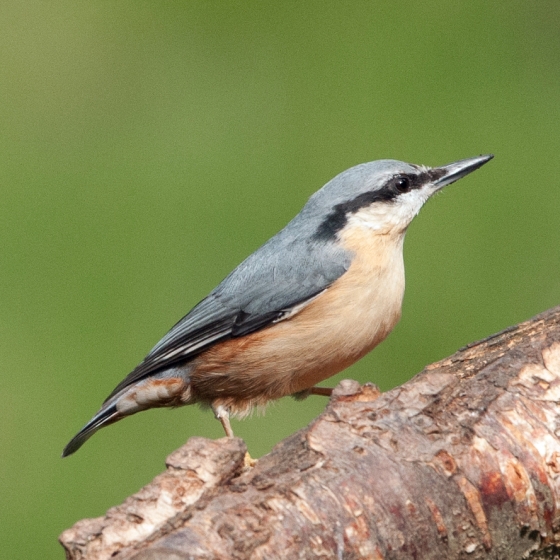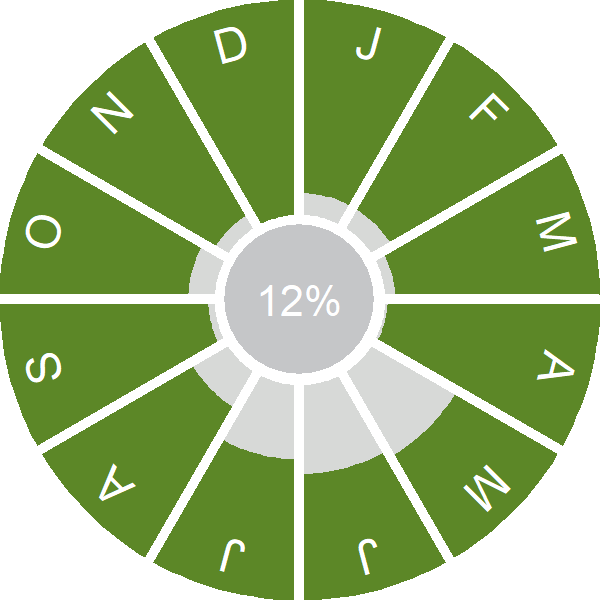Nuthatch
Sitta europaea (Linnaeus, 1758)
NH
 NUTHA
NUTHA  14790
14790

Family: Passeriformes > Sittidae

The Nuthatch is a charismatic inhabitant of woodland and an agile visitor to bird tables.
A handsome bird with a similar shape and structure to a woodpecker. The Nuthatch has a slate grey back, black eye stripe, white cheeks and orange breast; it is possible to distinguish male birds by their contrasting dark rufous flanks. Birds can be seen all year round in the UK, particularly in old deciduous woodland, although the species is absent from Northern Ireland and central to northern Scotland. The species possesses a range of loud whistling calls.
Nuthatches nest in tree holes or nest boxes, reinforcing the nest entrance with dried mud. Up to eight eggs are laid. The Nuthatch UK population trend shows a significant increase since the 1970s, which may be caused by a fall in the rate of nest failure and an increase in brood size and the number of chicks successfully reared per breeding attempt.
Exploring the trends for Nuthatch
Our Trends Explorer will also give you the latest insight into how the UK's Nuthatch population is changing.
trends explorerIdentification
Nuthatch identification is usually straightforward.
SONGS AND CALLS
Listen to example recordings of the main vocalisations of Nuthatch, provided by xeno-canto contributors.
Call
Song
Develop your bird ID skills with our training courses
Our interactive online courses are a great way to develop your bird identification skills, whether you're new to the hobby or a competent birder looking to hone your abilities.
Browse training coursesStatus and Trends
Population size and trends and patterns of distribution based on BTO surveys and atlases with data collected by BTO volunteers.
CONSERVATION STATUS
This species can be found on the following statutory and conservation listings and schedules.
POPULATION CHANGE
Nuthatch abundance in the UK has increased rapidly since the mid 1970s. The increase has been accompanied by a range expansion into northern England and southern Scotland (Balmer et al. 2013). The BBS map of change in relative density between 1994-96 and 2007-09 indicates that, despite general increase over that period, there was evidence of some decrease in Kent, Cornwall and western Wales. There has been an increase across Europe since 1980 (PECBMS: PECBMS 2020a>).
| UK breeding population |
+280% increase (1967–2022) 
|
Exploring the trends for Nuthatch
Our Trends Explorer will also give you the latest insight into how the UK's Nuthatch population is changing.
trends explorerDISTRIBUTION
Nuthatches are widespread in winter and the breeding season throughout Wales, most of England and southern Scotland. They are absent from the Channel Islands, Isle of Man, Ireland and much of Scotland. Across England, they are notably absent from the Fens and the arable farmland of East Yorkshire.
Occupied 10-km squares in UK
| No. occupied in breeding season | 1588 |
| % occupied in breeding season | 53 |
| No. occupied in winter | 1609 |
| % occupied in winter | 53 |
European Distribution Map
European Breeding Bird Atlas 2
Breeding Season Habitats
| Most frequent in |
Deciduous Wood 
|
Relative frequency by habitat
Relative occurrence in different habitat types during the breeding season.

DISTRIBUTION CHANGE
Both winter and breeding range of Nuthatches have expanded, for example by 38% in winter since the 1981–84 Winter Atlas. Range expansion, much of which has been in south Scotland, has also been accompanied by increases in relative abundance within the established range, particularly in western England and Wales.
Change in occupied 10-km squares in the UK
| % change in range in breeding season (1968–72 to 2008–11) | +34.9% |
| % change in range in winter (1981–84 to 2007–11) | +38.2% |
SEASONALITY
Nuthatch is recorded throughout the year, with detections peaking in late winter and early spring when the loud territorial song proclaims its presence.

Movement
Information about movement and migration based on online bird portals (e.g. BirdTrack), Ringing schemes and tracking studies.
RINGING RECOVERIES
View a summary of recoveries in the Online Ringing Report.
Biology
Lifecycle and body size information about Nuthatch, including statistics on nesting, eggs and lifespan based on BTO ringing and nest recording data.
PRODUCTIVITY & NESTING
Exploring the trends for Nuthatch
Our Trends Explorer will also give you the latest insight into how the UK's Nuthatch population is changing.
trends explorerSURVIVAL & LONGEVITY
View number ringed each year in the Online Ringing Report
Maximum Age from Ringing 
|
11 years 0 months 2 days (set in 2017) 
|
Typical Lifespan 
|
2 years with breeding typically at 1 year |
Adult Survival 
|
0.51 (Male: 0.55± Female: 0.47±)  
|
Exploring the trends for Nuthatch
Our Trends Explorer will also give you the latest insight into how the UK's Nuthatch population is changing.
trends explorerBIOMETRICS
Wing Length 
|
Adults | 84.1±2.2 | Range 81–88mm, N=1283 |
| Juveniles | 84.2±2 | Range 81-88mm, N=352 | |
| Males | 85.2±1.9 | Range 82–88mm, N=617 | |
| Females | 82.9±1.8 | Range 80–86mm, N=628 |
Body Weight 
|
Adults | 22.1±1.3 | Range 20.0–24.4g, N=1027 |
| Juveniles | 21.6±1.4 | Range 19.1–23.8g, N=310 | |
| Males | 22.5±1.2 | Range 20.5–24.6g, N=505 | |
| Females | 21.7±1.3 | Range 19.8–24.0g, N=487 |
Feather measurements and photos on featherbase 
CODES & CLASSIFICATION
Ring size 
|
B |
Field Codes 
|
2-letter: NH | 5-letter code: NUTHA | Euring: 14790 |
For information in another language (where available) click on a linked name
Research
Interpretation and scientific publications about Nuthatch from BTO scientists.
CAUSES AND SOLUTIONS
Causes of change
The demographic causes of the population increase appear to be an increase in the number of fledglings per breeding attempt, larger brood sizes and a decrease in daily failure rates. However, it is unclear what the ecological drivers of these changes are.
Further information on causes of change
The number of fledglings per breeding attempt has increased strongly, through an increase in brood size and a fall in nest failure rates.
There is little evidence relating to Nuthatch population change in the UK. However, studies from Europe provide evidence that mild winters are likely to have helped this species. Kallander (1997) used a long-term data set (1977-91) to provide good evidence that Nuthatches in a Swedish national park had a population size in spring which co-varied positively with winter temperatures and suggest that increases in population size may be associated with increasing mean winter temperature. Nilsson (1982, 1987) also found that mortality was concentrated in winter and that starvation was probably the major cause. However, a long-term study in Poland from 1975 to 1990 found that bird numbers in spring were not significantly correlated with the severity of the preceding winter, though winter survival was higher in the unusually mild winter of 1989/90, which had a rich supply of hornbeam seeds (Wesolowski & Stawarczyk 1991). It is not possible to say whether such factors have also operated in the UK, as the climate here is considerably less extreme.
Several studies have also reported a link between population size and the size of food availability in the autumn. A study of two Nuthatch populations in Sweden provided good evidence that autumn population size was correlated with the size of the hazelnut crop, suggesting food supplies play a role, although beechmast crop was not correlated with overwinter survival and nor was autumn population size correlated with the population density in spring (Enoksson & Nilsson 1983, Enoksson 1990). In the studies by Nilsson mentioned above, the main density-dependent factor, recruitment of young of the year to the autumn population, was positively related to the current beechmast supply and negatively to the density of adults (Nilsson 1982, 1987). A long-term study in Poland from 1975 to 1990 also found that Nuthatch numbers seemed to be influenced by autumn seed supply and also availability of caterpillars in the preceding spring (Wesolowski & Stawarczyk 1991). Another continental study in Europe found that local survival in autumn was higher in beechmast years for juveniles, but not for adults and that local winter survival was not higher in years with than in years without beechmast (Matthysen 1989). Thus there is some evidence that increases in population size are linked to food supplies, but again, this has not been directly tested for UK birds.
Although there is no direct evidence available, Nuthatches are known to favour dead wood, and so it is possible that they may have benefited from the increase in dead wood in the UK (Amar et al. 2010a).
In Belgium, competition for nest sites with the non-native, invasive Ring-necked Parakeet was found to be detrimental to Nuthatches (Strubbe & Matthysen 2009). However, there is evidence showing that this is not a problem in the UK at present (Newson et al. 2011).
Information about conservation actions
The population of this species has increased consistently since the 1970s and it has expanded its range northwards, hence it is not a species of concern and no conservation actions are currently required.
Conservation actions benefiting other woodland species may also help Nuthatch. Habitat fragmentation may prevent Nuthatches from finding new sites (Verboom et al. 1991; Bellamy et al. 1998; van Langevelde 2008), and the provision of more frequent suitable patches of woodland across the landscape may therefore enable further colonisation and range expansion. Fragmentation may explain why numbers are relatively low and there are gaps in distribution in eastern England (Bellamy et al. 1998).
PUBLICATIONS (1)
A method to evaluate the combined effect of tree species composition and woodland structure on indicator birds
Providing quantitative management guidelines is essential for an effective conservation of forest-dependent animal communities.
Links to more studies from ConservationEvidence.com
Would you like to search for another species?













Share this page